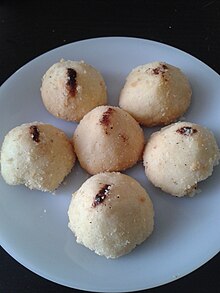Ghoriba
 Ghoriba biscuits | |
| Alternative names |
|
|---|---|
| Type | cookie |
| Course | dessert |
| Region or state | |
| Associated cuisine | Algerian, Moroccan, Tunisian,Libyan, Egyptian, Levant, Kuwait |
| Main ingredients | |
| Similar dishes | |
A ghoriba (Arabic: غريبة, also spelled ghribia, ghraïba, or ghriyyaba) is a type of cookie prepared in the Maghreb and other parts of the Arab world. It is a round, shortbread cookie made with flour, sugar, butter, and usually almonds. It is often served with Arabic coffee or Maghrebi mint tea. Ghoriba sometimes pronounce as Ghurayba, has been around in the Greater Syria area, Iraq and other Arab countries since ancient times.[1] They are similar to polvorones from Andalusia and qurabiya from Iran.[2][3][4]
Regional variations
Algeria
Ghribia (Algerian Arabic: غريبية) [5][6][7]
- Ghribia with almonds
- Ghribia with peanuts
- Ghribia with walnuts
- Ghribia with pistachios
Morocco
Ghoriba (Moroccan Arabic: غْرِيبَة)
- Mlouwza, made with almonds and sugar flavored with orange flower water
- Ghoriba bahla
- Ghoriba dyal zite
- Ghoriba mramla
Tunisia
Ghraïba (Tunisian Arabic: غريبة)
- Ghraïba bidha, made with wheat flour
- Ghraïba droô, made with sorghum flour
- Ghraïba homs, made with chickpea flour
Libya
- Ghoriba with peanuts
- Ghoriba with almonds
- Ghoriba with walnuts
Kuwait
See also
References
- ^ Salloum, Habeeb (Feb 28, 2012). The Arabian Nights Cookbook: From Lamb Kebabs to Baba Ghanouj, Delicious Homestyle Arabian Cooking. Tuttle Publishing. p. 138.
- ^ Williams, Stephanie (5 August 2012). "Lost and loving it in Morocco". Herald Sun. Retrieved 1 April 2015.
- ^ Kragen, Pam (19 March 2013). "Cookbook a love letter to Morocco". U-T San Diego. Retrieved 1 April 2015.
- ^ Catherine Hanger (2000). Morocco: World Food. Lonely Planet. p. 98. ISBN 1-86450-024-7.
- ^ Labourdette, Jean-Paul; Auzias, Dominique (2012). Alger 2012-2013 (in French). Petit Futé. p. 61. Retrieved 1 April 2015.
- ^ Bellahsen, Fabien; Rouche, Daniel (2005). Délices de Tunisie (in French). Paris: EDL. ISBN 2-84690-243-7.
- ^ Talhouas, Nathalie; Bonnet, Élodie; Volpatti, Céline; Bizos, Didier (2010). Douceurs du Maghreb; Beyrouth : Albouraq (in French). ISBN 978-2-84161-485-1.
